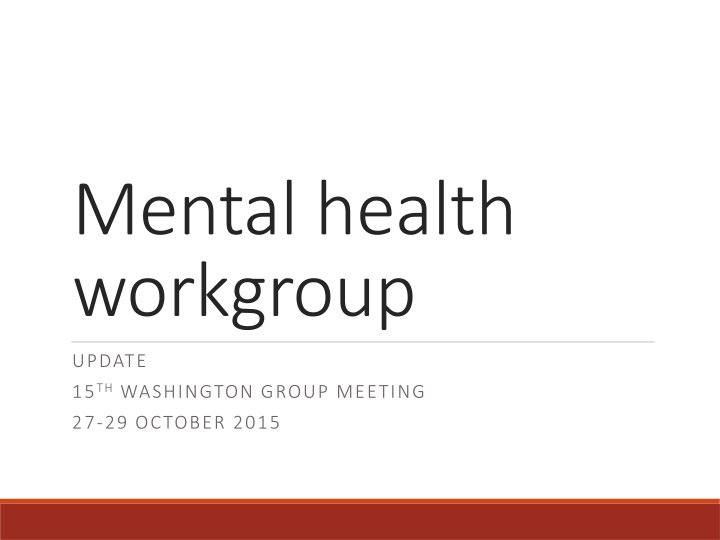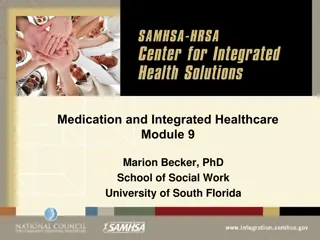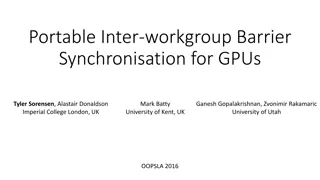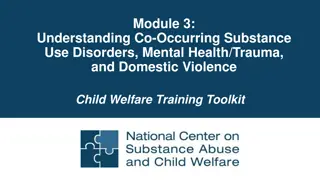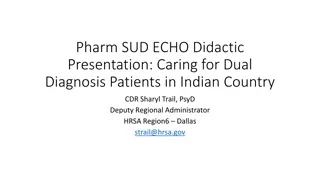Mental Health Workgroup Update on Disorders and Consequences
This update covers the 15th Washington Group Meeting held in October 2015, focusing on the DSM V definition of mental disorders, global burden of mental health issues, and the purpose of the mental health workgroup. It delves into the functional consequences of common and severe mental disorders, strategies for ensuring adequate coverage, review of performance measures, and the need for extended measures. The content emphasizes the importance of addressing cognitive, communication, and self-care difficulties along with social interactions in individuals with mental health disorders.
Download Presentation

Please find below an Image/Link to download the presentation.
The content on the website is provided AS IS for your information and personal use only. It may not be sold, licensed, or shared on other websites without obtaining consent from the author.If you encounter any issues during the download, it is possible that the publisher has removed the file from their server.
You are allowed to download the files provided on this website for personal or commercial use, subject to the condition that they are used lawfully. All files are the property of their respective owners.
The content on the website is provided AS IS for your information and personal use only. It may not be sold, licensed, or shared on other websites without obtaining consent from the author.
E N D
Presentation Transcript
Mental health workgroup UPDATE 15THWASHINGTON GROUP MEETING 27-29 OCTOBER 2015
DSM V Definition of mental disorders A mental disorder is a syndrome characterized by clinically significant disturbance in an individual's cognition, emotion, regulation or behavior that reflects a dysfunction in the psychological, biological, or developmental processes underlying mental functioning. Mental disorders are usually associated with significant distress in social, occupational, or other important activities .
Brief review of 2014 issues 1. Impact of mental, neurological and substance abuse disorders is high in global burden of disease 2. Different types of mental disorders Common mental disorders (CMD): Anxiety, depression, Post traumatic stress disorder Severe mental disorders (SMD): psychosis (e.g. schizophrenia), mood disorders (e.g. bipolar) and personality disorders. 3. Many existing scales for measuring mental disorders used primarily clinically and in clinical research 4. Reviewing existing measures not developing new ones
Purpose of MH workgroup 1. Ensure adequate coverage of common and severe mental disorders in the WG disability measures Symptoms Affect questions on anxiety, depression and fatigue Functional consequences of these symptoms activity limitations, participation restrictions and effect of environmental factors; e.g. social interactions, stigma, etc. 2. Add further measures to the WG Extended set it coverage is not adequate for functional consequences 3. Review the performance of the WG Affect (anxiety and depression) and Fatigue measures in the Extended Set relative to common scales used in surveys
Functional consequences of mental disorders: Some examples 1. Severe mental disorders: Cognitive difficulties Some communication difficulties Self care Social interactions 2. Common mental disorders: Self care ( I am too depressed to look after myself ) Difficulty with domestic, work activities and taking care of others Social interactions Manage to do most things but with less effectiveness or with much effort
Strategy for ensuring adequate coverage 1. Systematic review of activity limitations, and possible participation restrictions and environmental barriers commonly associated with common and severe mental disorders 2. Review the existing WG questions to determine the extent to which these address these domains of activity/participation and environment 3. If coverage is not adequate, develop a strategy to add 2 3 measures to the Extended Set and add to environmental factors Review existing survey measures and scales Select and test additional measures for the WG Extended Set OR Develop new measures
Strategy to review performance of AFFECT measures 1. Existing scales are often used in the surveys; e.g. Kessler 6 in the US National Health Interview Survey (NHIS) Centre for Epidemiologic Studies depression scale (CES-D) in South African National Income Dynamics Study (NIDS) Patient Health Questionnaire (PHQ2, 9, etc.) 2. Find data sets including a scale + WG Affect questions for further analysis WG questions + K6 in US National Health Interview Survey (NHIS) 3. Compare populations identified by each set of questions, e.g. Correlation between respondents for each set of questions Correlation between cutoff scores used to analyse the K6/CES-D/PHQ (or other scales used) and different cutoff points on the WG Affect questions
Systematic review: functioning and mental disorders 1. Formal way of searching the published literature on a given topic 2. Select terms to search the published or grey literature 3. Do the search and collect all the articles identified 4. Review the collected articles for: Type and severity of mental disorder Nature of activity limitation, participation restriction and environmental barriers 5. Analyze the data to extract: Typical profiles of functioning for different types and severity of mental disorders Differences by region, income status of countries, age, urban/rural 6. Compare the profiles to the WG Short and Extended sets
Search strategy 1. Terms Mental disorders OR psychiatric illness OR psychosis OR depression OR anxiety OR AND Activity limitation OR Function OR functional limitations OR . NOT Dementia OR intellectual disability OR child OR physical OR .. 2. Reviewing the documents Review titles and exclude non-relevant articles Review abstracts of remaining articles and exclude non-relevant ones Review full text of articles and exclude non-relevant ones 3. Extract information from all relevant articles
Report on systematic review 1. Review by WG mental health workgroup and strategy to address any gaps 2. Produce a peer reviewed publication 3. Discussions with mental health professionals Measurement of mental disorders and functional consequences in surveys Use of survey data on mental disorders
Over the next year . 1. Contribute to systematic review Lead at University of Cape Town (Margie Schneider) Contribution of grey/unpublished literature from countries Contribution of articles in languages other than English Title and abstract reviewing Data extraction Report writing 2. Review mental health measures in member countries Peru Genera Rivera Italy review of instruments South Africa Margie Schneider ?? Availability of data sets with WG Affect questions + another MH scale 3.
To consider 1. Link of MH to overall well-being Are CMDs just a normal adaptation to stressful living conditions? When is a condition clinically diagnosed? 2. Poverty and mental disorders CMDs tend to arise from poverty SMDs tend to lead to poverty as for other types of disabilities 3. Are the existing outcome measures appropriate? Can do activities but with big effort and maybe more slowly Look at outcome measures that reflect limited employment rather than no employment 4. Equalization of opportunities: Who counts as disabled or not? Depression and anxiety may be at risk of losing employment if miss days at work Severe mental disorders: stigma and exclusion
